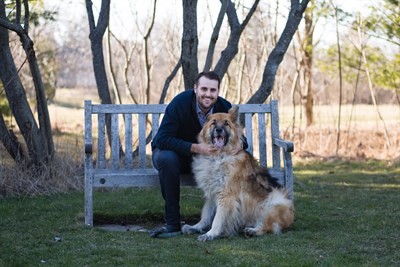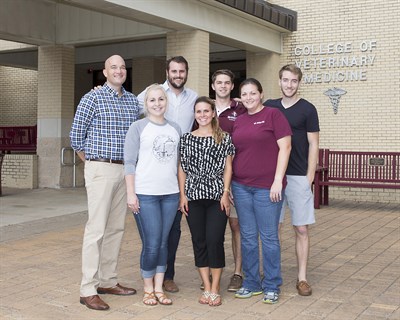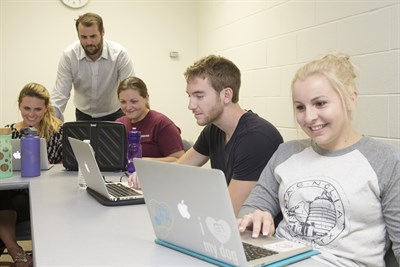Inspiring Innovation, Little by Little
For many veterinarians, especially those who operate their own businesses, entrepreneurship and business know-how are staples of their careers. But, business is changing. Information is more readily available than ever before, and information technology is growing exponentially. It’s time for veterinarians to adapt-that’s the philosophy of the newly hired director of innovation and entrepreneurship at the Texas A&M; University College of Veterinary Medicine & Biomedical Sciences (CVM), Dr. Adam Little.

For the veterinary profession and its business practices to adapt, changes must also occur in veterinary school, according to Little. Early in his career, he noticed a deficit in the way companies engage veterinary students, often “undervaluing their creativity and intellectual capacity.” Companies might reach out to veterinary students through presentations over lunch, hoping to piqué students’ interest in working with the company or trying their products. He said, “The way in which most companies engage veterinary students is by saying, ‘Here’s our new product. Here’s a pizza lunch. Go off and prosper.'” Although this strategy may have been effective in engaging students at one time, Little said it’s time to try something new.
In the summer of 2016, Little began the Veterinary Student Innovations Program (VSIP) for second- and third-year veterinary students. This program allows students to work with early stage startup companies with applications in veterinary fields. The companies that partner with VSIP are innovators, and working with them allows students to have a hand in shaping how technology impacts the future of veterinary medicine.
“We wanted to support the students and see if we could not only provide them with a curriculum in entrepreneurship, but also connect them to job opportunities and other opportunities for involvement. It’s actually gone really, really well,” Little said.
“This program is of value to students and the college in general,” said Dr. Stacy Eckman, a clinical assistant professor at the CVM who has mentored many students in VSIP. “Adam is clearly passionate about his work and so are the students.”
A Unique Learning Experience
As part of VSIP, five students were matched with startup companies, some of which had applications in veterinary medicine, but did not have veterinarians on their team to help guide the company. “We were paired with five different companies, and throughout the summer we helped them develop their market strategy in veterinary medicine because a lot of them weren’t veterinarians necessarily,” according to third-year veterinary student Anna Pennacchi.
The program represents a new paradigm in veterinary education, combining aspects of traditional learning styles and new teaching techniques. Students gained hands-on experience with the companies, while also being mentored by Little and other faculty at the CVM. They also received support and feedback from their peers in the program.
Through VSIP, Pennacchi was paired with Scopio Labs, a biotech startup based in Tel Aviv, Israel. “They are revolutionizing microscopy by using a digital platform,” she explained. “Rather than having a slide and looking at it under a microscope, you’ll have this desktop scanning device, where you put the slide in, and it takes an image of the entire slide. Then, it puts the image on your computer screen, tablet, or phone, so you can look at it and zoom in and out. It’s very user friendly and produces high-quality images.”

Additionally, Scopio’s technology has advanced diagnostic applications in veterinary medicine. Using technology similar to facial recognition software, Scopio is exploring digital identification of pathogens under the microscope. “It will help down the line in saving time on analysis in a veterinary clinic,” Pennacchi said. “The software can either help veterinarians come to a conclusion faster or it can make a diagnosis for you. It would be something that every veterinarian could have in their clinic at a comparable price to your average microscope.”
For Pennacchi, an officer in the CVM’s Veterinary Business Management Association, VSIP was an ideal way to further explore her existing interest in business. “I learned a lot about business operations, business management, and business development within a startup company,” she said. “I think VSIP is an awesome program for any veterinary student with an interest in business and innovation. Everyone who participated enjoyed it.”
Similarly, third-year veterinary student Tyler Kosich said, “This program definitely gave me more confidence in a business sense, and I’ve always wanted to eventually own my own practice.”
Kosich was paired with Embark, a company that sequences canine genomes and identifies breed and medically relevant genetic information. “They provide a super detailed genetic history of your dog,” he said. “They can fairly accurately tell you the breed composition of your dog, but what I found most interesting is that they test for 160 genetic diseases.” This sort of information can be invaluable to veterinarians in developing a long-term health plan for their canine patients.
At Embark, Kosich was actively involved in the company. “I definitely contributed more than I thought I would have. I had a variety of duties, such as contributing to their information database,” he said. “I wrote and rewrote a lot of their descriptions. I also met with veterinarians and got their opinions on Embark. I created a survey I sent out to veterinarians for feedback.”
Like all the students in VSIP, Kosich was embedded within the company and made to feel part of the team. “I was very ingrained in their team, and I talked to everyone. It was just a good team-oriented atmosphere,” he said.
An Entrepreneur from the Beginning
The vision of VSIP grew through Little’s early career experiences. Even in veterinary school, Little was an entrepreneur, sometimes skipping class to pursue his next business venture. However, he said the curriculum did not always accommodate his efforts. This ultimately fueled Little’s desire to provide these opportunities to veterinary students. “The process of learning about business in veterinary medicine is so important to veterinary students’ careers. Being able to give students an outlet to be creative and think differently in big institutions is critical.”

After graduation, Little put his skills to work, joining LifeLearn, a company in Guelph, Ontario. While there, Little led a team that was tasked with using artificial intelligence to build a decision support tool for veterinary practitioners. “We were building a tool that was using an IBM Watson artificial intelligence platform to help veterinarians make better, quicker decisions in practice,” he explained.
Creating such a technology may seem like a time-consuming process, and at first it was. The project team had to generate both the questions clients would ask and the answers the veterinarians would give, a process requiring much research and forethought. “You do that process tens of thousands of times, and so it’s incredibly laborious in a lot of cases,” Little said.
But, Little had an idea: crowdsource the task. He selected 20 veterinary students to help. “We separated them into pairs,” he said. “And, they chose a condition that they were interested in from a list of 100. They ended up creating question and answer pairs through their conversations, and then they go into the source material and find it. In five hours, they did three times more work than we had done in three months.”
This spurred Little to hire 75 veterinary students. “Over the course of the next four months, we had 10 times more question and answer pairs than anybody in the world that was working on Watson, which was pretty cool,” he said. “If we did that with 75 students, what could you do with 1,000 or 10,000? What problems could you solve? That’s the reason that we’re building this network.”
These experiences laid the foundation for Little’s work with VSIP at the CVM. He said, “I honestly believe the best way for us to tackle some of the significant challenges of the profession is by having a more entrepreneurial mindset and helping prepare students for that future. That’s the lens that we brought to this initial program.”
The Future is Here
Being on the edge of innovation has its challenges. Merging modern and traditional aspects of veterinary education is no easy feat. But, with the first round of VSIP being a success, Little plans to continue the program and recruit more students.
To Little, the stakes are too high not to move forward. “The pace of change in the world is greatly accelerating, largely due to advancing technologies. In veterinary medicine, we are beginning to see the early days of this,” he said. “Knowing that these technologies are going to be transformative and knowing that there are opportunities to build something new, we should ask ourselves, ‘How does an academic institution drive training for the next generation of students and help push the profession forward in a positive way?’ We are starting to shape that answer.”


